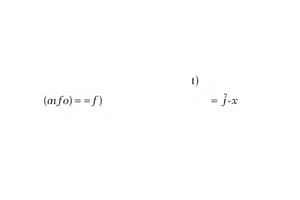Podcast
Questions and Answers
Which type of function is represented by the ordered pairs (1,2), (3,4), (5,6), (7,8), (9,10)?
Which type of function is represented by the ordered pairs (1,2), (3,4), (5,6), (7,8), (9,10)?
- Many-to-one
- Many-to-many
- One-to-one (correct)
- One-to-many
What type of relation do the ordered pairs (2,3), (2,4), (5,3) represent?
What type of relation do the ordered pairs (2,3), (2,4), (5,3) represent?
- Many-to-one
- Many-to-many
- One-to-one
- One-to-many (correct)
Given the ordered pairs (1, 2), (2, 2), (3, 4), (4, 5), (5, 5), which type of function is illustrated?
Given the ordered pairs (1, 2), (2, 2), (3, 4), (4, 5), (5, 5), which type of function is illustrated?
- Many-to-many
- One-to-many
- One-to-one
- Many-to-one (correct)
The relation defined by the pairs (1, 2), (2, 3), (3, 4), (1, 3), (2, 4) is an example of which type?
The relation defined by the pairs (1, 2), (2, 3), (3, 4), (1, 3), (2, 4) is an example of which type?
Which of the following sets of ordered pairs is an indication of a one-to-many relationship?
Which of the following sets of ordered pairs is an indication of a one-to-many relationship?
Which of the following best describes a one-to-one function?
Which of the following best describes a one-to-one function?
In which scenario would a many-to-many relationship be represented?
In which scenario would a many-to-many relationship be represented?
Which of the following characteristics defines a many-to-one relationship?
Which of the following characteristics defines a many-to-one relationship?
Given a set of ordered pairs, if the pairs (3,2), (5,6), (7,2), (9,8), (10,5) are represented, which type of function do they illustrate?
Given a set of ordered pairs, if the pairs (3,2), (5,6), (7,2), (9,8), (10,5) are represented, which type of function do they illustrate?
If a relation is defined by the pairs (1,1), (2,2), (3,3), (1,4), (2,5), which type of relation is it?
If a relation is defined by the pairs (1,1), (2,2), (3,3), (1,4), (2,5), which type of relation is it?
Flashcards are hidden until you start studying
Study Notes
Understanding Relations and Functions
- A relation is a set of ordered pairs, representing a relationship between two sets of values.
- A function is a specific type of relation where each input corresponds to exactly one output.
Types of Functions
-
One-to-One Function:
- Each input corresponds to a distinct output; no two different inputs share the same output.
- Example: {(1, 2), (2, 3), (3, 4), (4, 5), (5, 6)}
-
Many-to-One Function:
- Multiple inputs can map to the same output; different values in the domain correspond to the same value in the range.
- Example: {(1, 2), (2, 2), (3, 2), (4, 3), (5, 4)}
-
One-to-Many Function:
- A single input can correspond to multiple outputs; this does not qualify as a function in standard definitions since one input cannot have multiple outputs.
- Example that illustrates relation, not function: {(1, 2), (1, 3), (1, 4), (2, 5), (3, 6)}
-
Many-to-Many Function:
- Multiple inputs can relate to multiple outputs; like one-to-many, this structure does not define a function in the strict sense.
- Example that illustrates relation, not function: {(1, 2), (1, 3), (2, 2), (3, 4), (3, 5)}
Summary of Ordered Pairs
- Ordered pairs are foundational in illustrating relations and functions.
- Each ordered pair consists of a domain (input) and a range (output).
Importance in Mathematics
- Understanding the distinctions between these types of functions helps in solving complex problems and modeling real-world scenarios.
- Applications range from computer science to economics and beyond, where functions are essential for data analysis and predictions.
Studying That Suits You
Use AI to generate personalized quizzes and flashcards to suit your learning preferences.




